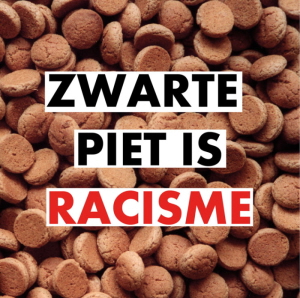Adding Chinese and Asian Black Petes just makes it all more racist: the white man as lord over people of various colours

Last year Doorbraak activist Jennifer van Leijen initiated a campaign to stop the Dutch government from subsidizing blackface (Zwarte Piet or Black Pete) on children’s television. Seven thousand people already signed. Van Leijen regularly writes updates. Here are numbers 6 and 7 (also read numbers 1, 2, 3, 4 and 5).
6. Utrecht anti discrimination initiative reveals suspicious flaws in Dutch anti discrimination policy
Utrechts anti discrimination bureau (called: Art. 1 Midden Nederland) have started an initiative to ban the blackface caricature in Utrecht. I have been assured that amongst the signatories, are the organisers of the racist Sinterklaas welcome parade. Why, oh why, would the organisers of a racist parade sign a document calling for change? Why can’t they decide for themselves that they won’t organise a racist parade? It doesn’t make sense.
It makes transparant the fallacy that the Utrecht municipal government are simply following the trend set by the parade organisation. After I received an e-mail from the University of Utrecht, it becomes more clear that the Utrecht municipality have the power to keep the racist parade going. The university of Utrecht have been granted the use of a university building by the municipal government, and the university of Utrecht therefore feel an obligation to give something back.
A spokesman for the University of Utrecht wrote “The University of Utrecht has been given the building as gift from the municipal city government, and making the property available for the parade began as a gesture years ago, to give something back to the city.” The spokesman added that the University don’t use blackface caricatures as part of the decorations within the building, and the University applauds that the issue is discussed.
However, and this is a part that makes no sense: the university of Utrecht also agree with ‘a gradual change?’ Discrimination should be eliminated; it’s not possible to gradually decrease offensiveness (just one racist caricature is discriminatory, so reducing the racist caricatures doesn’t actually change the situation!). These caricatures are based on slaves: shouldn’t the Utrecht anti discrimination organisation, Art.1 Midden Nederland, reject all references to the Netherlands shameful slave-trade past? As for the University of Utrecht, their apathy towards human rights in this situation has been described in this article.
7. Blackface parade broadcast live on Dutch national television on November 18th 2017
On november the 9th, the first of a daily series of broadcasts begins telling a story about the approaching white man and his generic slaves (known as Petes.) This year we have been told that not all the Pete’s will be black. A spokesman described it as being more like 50 shades of grey (with a few blackface people). The white establishment feign cluelessness: because it should be known that even one person in blackface is offensive and totally unacceptable.
But in addition to this, there is an added pain. Anti-black racism includes the concept that the whiter a person is, the more acceptable they are. It created division within black communities because in the days of transatlantic slave ownership, it often meant the difference between preferential treatment from the slave owner (the difference between pure misery and SLIGHTLY better circumstances). In some twisted way, making the slaves a collection of different shades (including making some Chinese, some Asian) as has happened in some television programmes in the Netherlands, adds another dimension to the racism (that the white man is lord over people of various colours).
And there is something really worrying about preserving the black Afro hairstyles on these slaves. Every year the cinemas show a blackface film – this year, the slaves have Afro hair and soot smears instead of complete blackface on their faces (which doesn’t make sense because their clothes are completely clean). It reveals the insincerity behind the changes.
Last year the Dutch Children’s Ombudswoman declared that the blackface phenomenon is discriminatory: she did this after speakers at the 20th European Network of Children’s Ombudspersons Conference (in Vilnius, Lithuania) openly criticised the racism in the Netherlands. The Dutch state still hasn’t taken active steps to eliminate this racism – and are still subsidising it. Mayors are still publicly involved in blackface parades, and national television still televises these blackface parades. International pressure is needed to shame the government into doing the right thing.
Jennifer van Leijen
